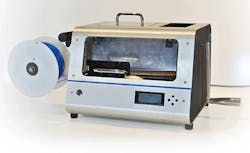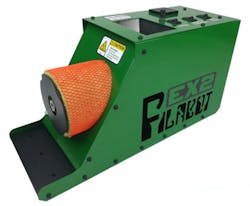Growth in 3D printing marches on at an annual 26% clip. While new printers keep increasing the print speeds and range of materials that can be used, data on recycling these materials has been sparse. In July 2017, CNBC reported the world has produced over 9 billion tons of plastic since the 1950s, and only about 9% was recycled. If 3D printing is going to further increase plastic consumption, will there be a pile of plastic prototypes lining the landfills?
In a recent report in 3D Printing and Additive Manufacturing, Isabelle Anderson wrote about the mechanical properties of recycling one of 3D printing’s most popular materials. PLA, short for polylactic acid, is currently the standard filament type with the lowest barrier to entry in use. In the past, acrylonitrile butadiene styrene (ABS) was considered the optimal material for best print appearance. However, in the last few years, optimizations to PLA formulas and print settings have made this thermoplastic the best choice for general, run-of-the-mill 3D-printer projects and household goods you would create.
This is probably why the report used PLA (to find out more about other materials, check out “What’s the Difference Between Recycling PET and HPDE?” below). However, it was interesting that since PLA is a biodegradable thermoplastic, it made it harder to recycle. For example, if a test sample operates in a closed loop, are you gaining an accurate representation of how recyclable it is?
Production of the ProtoCycler, which is capable of grinding and re-extruding plastics for 3D printing, began after a successful crowd-sourcing campaign.
Going from a printer to a tensile tester, right back to the printer, only degrades the polymer by a small amount. In a number of closed-loop studies, samples were recycled and many times without much fluctuation. The problem arises when you include plastic that has been degraded or has an unknown origin. PLA is more sensitive to UV light and temperature compared to ABS. Since PLA is more likely to degrade, it is hard to determine what the mechanical properties would be if it were to be recycled.
Knowledge of 3D-printed materials is rather limited, but there are a few recycling platforms on the market. Whether testing for form, fit, or knick-knacks, these platforms can help reduce the amount of waste. There were some problems with the recycled PLA versus the virgin PLA. In Anderson’s report, problems emerged due to the nozzle becoming clogged with the recycled material.
Test Method and Results
The PLA was extruded through an entry-level 3D printer into tensile and shear specimens. After being tested, they were ground up, extruded into filament, and 3D printed again (see table).
“The tensile modulus of elasticity was statistically unchanged. Although the average mechanical properties before and after recycling were similar, there was more variability in the results of the recycled filament,” wrote Anderson. “Additionally, when printing with the recycled filament there was some nozzle clogging, while none occurred with the virgin filament. Overall, the mechanical properties of specimens 3D printed from recycled PLA filament were similar to virgin properties, encouraging further development in the area of recycling 3D printed filament.”
It seems 3D printing is leaving a wake of failed prints and no-longer-interesting knick-knacks behind it. Known as a minimal waste process, additive manufacturers may need to find a place other than the trash can for old or failed parts if they want to continue to support that maxim. Fortunately, some companies are trending toward environmental plastics and processes to reduce waste in more than one way. But in order to grow these companies, designers need more data so that they can better design with the recycled material.
At Maker Faire 2015, Filabot displayed its multiple desktop solution, which allows users to extrude or pelletize recycled or new types of plastics.
What’s the Difference Between Recycling PET and HDPE?
Polyethylene terephthalate (PET) recycles well. In one closed-loop test, the mechanical properties of PET were still close to published values after 2,000 cycles. In open-loop tests, it wasn’t possible to determine how many times the material was recycled, but they remained close to published values.
High-density polyethylene (HDPE) degrades and experiences chain scission followed by the chains cross linking. This is evident during impact testing, as cross linking will increase the impact the material’s strength. In closed-loop testing, recycled HDPE stayed within published values, but in an open-loop test, the impact strength varied, indicating the material was degraded.
This shows the importance of understanding the origins of post-consumer polymer. However, recycled batches could be produced and tested. Either the tested material properties could be advertised on the product, or additive may be added to help the material fall within published values. Unfortunately, this all costs money, and plastics are cheap. Adding in these tests and additives makes it difficult to compete with virgin plastic.
Despite this, I am curious if anyone is trying to recycle PET bottles or any of the other economy polymers into 3D-printing filament. I think it would be interesting to collect some bottles, process them into a Filabot, and print parts.




